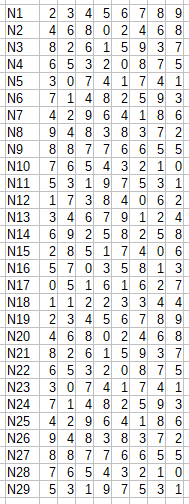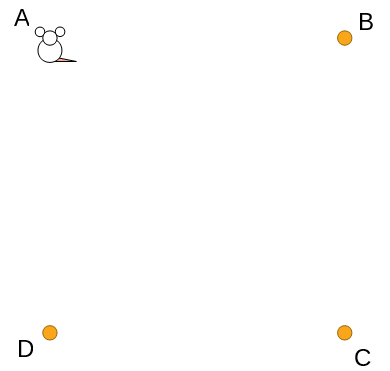-
Posts
1756 -
Joined
-
Last visited
-
Days Won
25
Content Type
Profiles
Forums
Events
Gallery
Blogs
Everything posted by plasmid
-
It looks like that will indeed work. And I know I just said this about the previous solution, but now I really don't think there's a way to do it with any fewer breadcrumbs. As for ever finding a general solution to the breadcrumbing problem,
-
I would have to disagree with that since I just posted a solution with only one breadcrumb going from C to E. But I do agree that there probably isn't a better solution for the pentagon case than adding five new breadcrumbs.
-
That's the best solution so far, and matches the number of breadcrumbs I had even though it seems substantially different. I strongly suspect that there aren't any better solutions with fewer breadcrumbs, although I don't know of a way of proving it, let alone finding a general solution for determining the fewest number of breadcrumbs it would take to "teach" a dumb but hungry mouse to travel any arbitrary path. And I sort of doubt that anyone has figured it out since this sort of puzzle isn't a common thing. But I'll go ahead and share my perspective on the problem and the solution I reached.
-
That's correct. The mouse can take whatever path you want it to take, even if it's not straight lines from A to C to E to B to E, as long as it reaches the specified destinations in the specified order. And it took me more than a day or two, so I certainly wouldn't fault you if it takes more than that.
-
Sort of a hint... (But note the edit below the spoiler before you open the spoiler.) Edit: To clarify: the mouse doesn't need to travel along straight lines to each of the points. It can go along any curved, jagged, or whatever sort of two-dimensional path you want, which makes the problem more interesting. If that's enough clarification, then don't open the spoiler :3
-
CaptainEd has the best answer so far and asked to see my solution so I'll go ahead and PM it, but will leave this open in case anyone else drops in and wants to take a crack.
-
Putting coordinates into a spreadsheet and calculating distances sure is a good way of checking your work; now I wish I had thought of doing that! I believe I have a way of doing it with five breadcrumbs aside from the five vertices. Up to you if you'd like to look at it a little longer or if I should go ahead and convert my chicken scratch to an intelligible post when I get a chance.
-
Well, I blew it with the first guess...
-
I see what you're saying -- if we don't care whether the mouse goes from C to B or from C to D then that would work and you could let the mouse just flip a coin after it reaches C. The OP was phrased sort of ambiguously since I first talked about making the mouse take as many diagonals as possible (in which case that would be fine to do) and later said the specific letter sequence of ACBD (in which case that wouldn't). The only thing I'd say, though, is that if you drop a breadcrumb in region E, it seems like the mouse would go eat the breadcrumb there and then go to either B or D instead of C -- either of those two points would be closer to region E than C is.
-
Yep, this gets harder than it looks
-
... wut? ... Wat? The mouse always goes and eats the nearest bit of food to its current position. So like Captain Ed says, putting multiple pieces of food at one spot wouldn't be helpful. If the mouse starts at point A of the square, then the food at either B or D will be closer than C (even if there are multiple breadcrumbs at C), so the mouse will go to the closer food at either B or D. Nah, this mouse really is pretty dumb. It won't manage to learn, it'll still keep right on pursuing whatever bit of food is closest until it eats everything in sight.
-
I'll go with ...
-
This gets tricky with rolls like (1, 1, 6) that look isosceles but don't actually form triangles. How would you handle such rolls? Would you omit rolls that don't form a triangle from analysis (equivalent to saying that if you get a roll that doesn't form a valid triangle then roll again), or count them as a failure to form an isosceles triangle? And would you consider a "straight line" throw like (3, 3, 6) to be a valid triangle albeit with zero area or nah?
-
This sounds like it might be a homework problem, so I won’t flat out answer it but will give a hint on how to approach it.
-
Right on, that solves the square problem with the minimum number of breadcrumbs.
-
Good start, that would work, but the square can be done with fewer breadcrumbs.
-
That's definitely not a silly question. In the question I had in mind, the paths don't need to be straight lines. But down the line when we solve the pentagon case and start thinking about generalizations, we could talk about solving for cases with straight line paths.
-
You could be telling the truth because such a number does exist. Of course I can't say with certainty that you're telling the truth because I don't know whether you actually have such a number in mind right now. Back in a bit with a description of how to handle this problem.
-
In case this helps clarity: the warm up problem is to take this setup with the mouse at A (I told you it was cute!) and breadcrumbs at B, C, D, and your job is to place more breadcrumbs to ensure the mouse goes first to C, then B, then D. Ideally, using as few breadcrumbs as possible. The real problem is to take this setup with breadcrumbs at points B, C, D, E and place more breadcrumbs to make the mouse go first to C, then E, then B, then D. Again, using as few breadcrumbs as possible.
-
Warning: This is a problem I have not yet found an optimal (or even very good) solution to. But it seems awfully non-trivial, and not in a genre that I've seen before, so I'm throwing it out there for the Den. ( @bonanova that means you should take a look.) You have a pet mouse. It's an awfully cute mouse. Kind of like those mice on Pinky and the Brain. And you'd like to make it even cuter by teaching it some tricks. The only problem is that your mouse is, well... let's just say it has the brain of a mouse so it's kind of hard to teach it any tricks. But it is very good at eating food. In fact, it will always manage to find the closest morsel of food and go eat it, then find the closest from its new position and go eat that, etc. until it eats everything in sight. So, you'd like to "teach" your mouse to do some tricks given that behavior. The first exercise is to place morsels of food at the corners of a square and place breadcrumbs so the mouse runs to diagonal corners as much as possible. In other words, suppose you have a square with points A, B, C, D in clockwise order with the mouse starting at point A and you'd like to make the mouse go to point C (diagonal from point A), then point B (one of the two remaining), then point D (diagonal from point B). There are already some breadcrumbs at points B, C, and D (since there need to be breadcrumbs there if you want the mouse to stop at those points) and your goal is to place breadcrumbs to make the mouse go from A to C to B to D while placing as few breadcrumbs as possible. That first exercise might be a challenge for your kid brother, but for a BrainDen level challenge (the one I haven't convinced myself I've found an optimal solution for yet): Instead of a square, suppose you have a regular pentagon with points A, B, C, D, and E in clockwise order and want to get the mouse to go from A to C to E to B to D?
-
If anyone tries asking people this question in real life, a follow up after they've heard that answer: If a ship with tourists from Europe sinks on the way from Alaska to Australia while in contested Chinese waters, where would the deceased passengers be buried?
-
Nailed it, Thalia!
-
Push your feet upon on my pedals While the rubber meets the road Then as urge for fun unsettles Lose my grip, so off we go My engine wrapped around a tree Your limbs are but a price to pay All for this pursuit of glee On single foot now make your way




